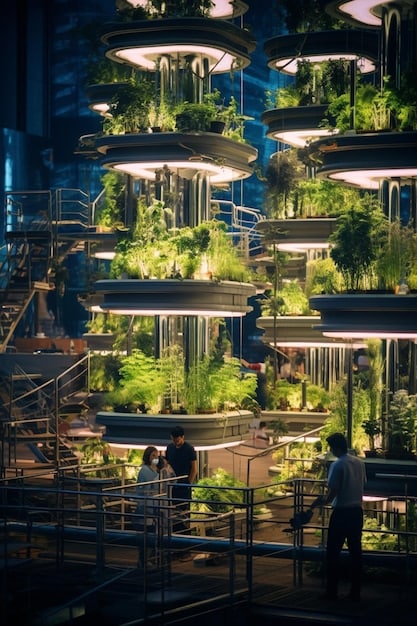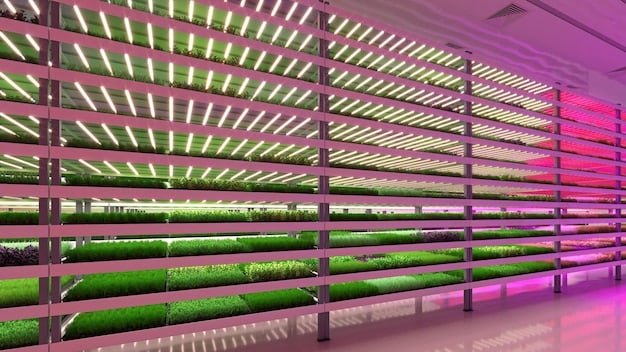Urban Farming Revolution: Can Vertical Farms Feed 15% of the US by 2030?

The Future of Urban Farming: Will Vertical Farms Supply 15% of US Produce by 2030? Experts project significant growth in vertical farming, but achieving 15% of US produce by 2030 depends on technological advancements, investment, and overcoming challenges like energy consumption and scalability.
The agricultural landscape is evolving, and the concept of **The Future of Urban Farming: Will Vertical Farms Supply 15% of US Produce by 2030?** is gaining traction. But is it a realistic goal?
The Rise of Urban Farming
Urban farming is changing how we think about food production. It’s about growing crops in urban areas, using spaces like rooftops, balconies, and vacant lots. It addresses critical issues such as food security, transportation costs, and environmental impact.
What is Urban Farming?
Urban farming encompasses various methods of growing food in urban environments. It aims to bring food production closer to consumers, reducing the distance food travels from farm to table.
Different Types of Urban Farming
Urban farming includes rooftop gardens, community gardens, aquaponics, and vertical farms. Each has its own approach, advantages, and challenges, catering to diverse urban settings and needs.

Benefits of Urban Farming
Aside from reducing food miles, urban farming can improve access to fresh produce in underserved communities. It can create green spaces, promote sustainability, and even provide educational opportunities for city residents.
- Improves food security in urban areas.
- Reduces transportation costs and carbon footprint.
- Creates green spaces and enhances community engagement.
- Provides access to fresh, healthy produce.
Ultimately, urban farming plays a crucial role in shaping sustainable food systems, enhancing community well-being, and improving access to fresh, healthy produce in urban environments.
Vertical Farms: A Key Component
Within urban farming, vertical farms stand out as a high-tech approach, maximizing space and resources. They show great promise, but also bring their own set of challenges.
Vertical farms are indoor facilities where crops are grown in vertically stacked layers. Using controlled environments, these farms optimize factors like light, temperature, and humidity to maximize yields.
How Vertical Farms Work
Vertical farms use hydroponics, aeroponics, or aquaponics to deliver nutrients directly to plant roots. LED lighting provides the necessary energy for photosynthesis, and sensors monitor environmental conditions.
Advantages of Vertical Farms
Vertical farms offer several key advantages. They can produce crops year-round, regardless of weather conditions. They use significantly less water compared to traditional agriculture and eliminate the need for pesticides and herbicides.
Challenges of Vertical Farms
Despite their potential, vertical farms face challenges such as high initial investment costs and significant energy consumption. Optimizing energy use and reducing operational costs are crucial for their long-term sustainability.
- High initial investment costs can be a barrier to entry.
- Significant energy consumption requires sustainable solutions.
- Scalability and market competitiveness need to be improved.
- Technological innovation is key to overcoming these challenges.
In conclusion, vertical farms represents an innovative approach to urban agriculture, offering numerous benefits while also presenting significant technological and economic hurdles that need to be addressed.
Can Vertical Farms Supply 15% of US Produce by 2030?
The ambition to supply 15% of US produce via vertical farms by 2030 is an ambitious objective. Evaluating its feasibility requires careful consideration of current trends, technological advancements, and market dynamics.
Achieving this goal is not merely a matter of technological capability. It also depends on economic viability, consumer acceptance, and the integration of vertical farms into the broader agricultural ecosystem.
Current Production Capacity
Currently, vertical farms contribute a relatively small fraction of the total US produce supply. Scaling up to 15% would require exponential growth in the industry.
Projected Growth and Trends
The vertical farming industry is projected to grow significantly in the coming years. Factors such as increasing urbanization, rising demand for local produce, and technological advancements are driving this growth.

Technological Advancements Needed
Key technological advancements are needed to make vertical farms more efficient and cost-effective. This includes improvements in LED lighting, automation, and nutrient management systems.
- Increasing the efficiency of LED lighting systems.
- Developing more precise climate control technologies.
- Implementing automated harvesting and packaging solutions.
- Optimizing nutrient delivery systems for plant health.
In sum, vertical farms providing 15% of US produce by 2030 is a monumental task that calls for significant technological advances along with thoughtful integration into the existing agricultural framework.
Economic and Investment Factors
The economic viability of vertical farms is crucial for achieving widespread adoption. Investment in research, development, and infrastructure is essential for scaling up the industry.
Without strong economic foundations, the potential benefits of vertical farms could remain unrealized. Therefore, it’s important to examine where these farms stand regarding costs, grants, and market potential.
Initial Investment Costs
Setting up a vertical farm requires significant capital investment. Costs include land acquisition, construction, equipment, and technology.
Operational Costs
Operational costs, such as energy, labor, and maintenance, also play a key role in the economic equation. Reducing these costs is critical for long-term profitability.
Government Support and Incentives
Government policies, subsidies, and incentives can help stimulate the growth of the vertical farming industry. Support for research and development is particularly important.
In other words, a combination of private investments, public support, and continual improvements in operational efficiency will be critical to reduce expenses and ensure profitability.
Challenges and Obstacles
Despite their potential, vertical farms face various challenges that need to be addressed. These challenges range from technological and economic to social and regulatory.
Addressing these obstacles will require innovative solutions, strategic partnerships, and a collaborative effort from all stakeholders involved. Here are some of those challenges.
Energy Consumption
High energy consumption is a major concern for vertical farms. Finding sustainable and renewable energy sources is essential for reducing their environmental impact.
Scalability Issues
Scaling up vertical farm operations to meet significant portions of urban food demand presents logistical and financial challenges. Overcoming these issues is crucial for realizing the potential of vertical farming.
Market Competition
Vertical farms must compete with traditional agriculture and other forms of urban farming. Differentiation, branding, and marketing are important for creating a competitive advantage.
In short, overcoming these challenges is crucial for realizing the full potential of vertical farming and achieving widespread adoption across the United States.
The Role of Consumers
Consumer acceptance and demand are critical for the success of vertical farms. Educating consumers about the benefits of vertical farming can help drive market growth.
Without consumer support, the vertical farming movement may not be able to truly gain traction. After all, consumer choices are a large part of what impacts market trends.
Consumer Awareness
Many consumers are unaware of vertical farming and its benefits. Raising awareness through education and marketing campaigns can help increase demand.
Consumer Preferences
Understanding consumer preferences for taste, appearance, and price is essential for producing crops that meet market demand. Tailoring production to meet consumer needs can help drive sales.
Local and Sustainable Food
Consumers are increasingly interested in local and sustainable food options. Vertical farms can capitalize on this trend by promoting their products as fresh, locally grown, and environmentally friendly.
- Educating consumers about the benefits of vertical farming.
- Highlighting the freshness and nutritional value of produce.
- Promoting the sustainability and environmental benefits.
- Building trust through transparency and traceability.
In conclusion, the success of vertical farming hinges on consumer behavior, and by educating and engaging consumers, the industry can increase demand, drive market growth, and unlock its full potential.
| Key Point | Brief Description |
|---|---|
| 🌱 Urban Farming | Growing food in urban areas to address food security and reduce transportation costs. |
| 🏢 Vertical Farms | Indoor facilities growing crops in vertically stacked layers using controlled environments. |
| 💡 Tech Advances | Efficiency in LED lighting, automation, climate control, and nutrient management is crucial. |
| 🤝 Consumers | Consumer awareness and demand are critical for the success of vertical farms. Education is essential. |
FAQ
▼
Vertical farming is a method of growing crops in vertically stacked layers, often indoors, using controlled environments to optimize plant growth and yield.
▼
Vertical farms offer year-round crop production, reduced water usage, elimination of pesticides, and localized food production, enhancing food security.
▼
Challenges include high initial investment costs, significant energy consumption, scalability issues, and the need for continuous technological innovation.
▼
The goal is 15% by 2030. Achieving this depends on technological advancements, investment, and overcoming energy and scalability challenges.
▼
Consumer awareness and demand are critical. Educating consumers can drive market growth, helping vertical farms thrive and scale effectively.
Conclusion
The Future of Urban Farming: Will Vertical Farms Supply 15% of US Produce by 2030? is a prospect filled with both promise and challenges. While the industry has potential, achieving such a substantial share of the market requires overcoming significant obstacles related to technology, investment, and consumer adoption. As technology advances and as more support is given to these kinds of vertical efforts, farms may be able to truly create something amazing.





